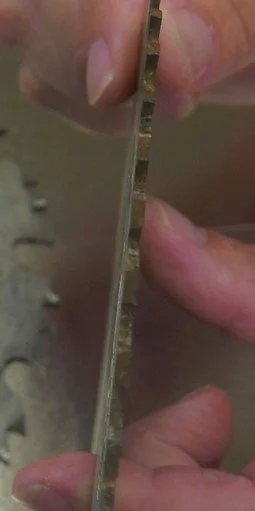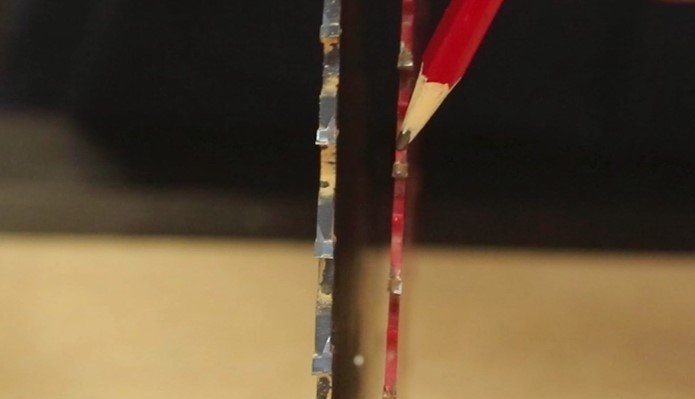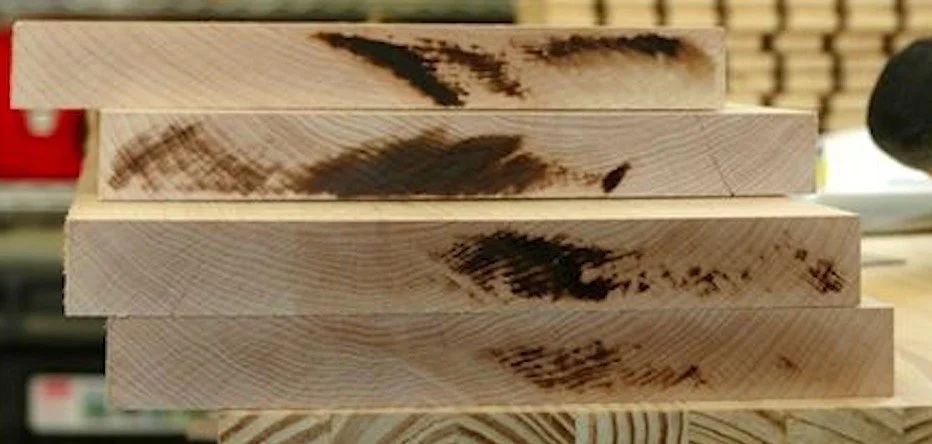THE THIN KERF DEBATE: A WOODWORKER’S PERSPECTIVE
When I started out woodworking as a kid, the saw blades we used were much different than modern blades. For one, they are smaller—9 inches in diameter instead of the modern 10-inch blades. They didn’t have carbide teeth either; the tips were just steel, which meant they had to be sharpened frequently. But what really stands out to me is how thin they are—67 thousandths of an inch, or just over a millimeter and a half. Compared to a modern blade, which is 83 thousandths, or just under 2-1/4 mm. That’s a big difference. But it doesn’t tell the whole story.
Most modern saw blades have carbide teeth, which are wider than the blade’s body, also known as the saw plate. This causes the blade to cut a wider kerf through the wood than the actual thickness of the blade. The kerf created by the blade below is about 1/8 inch wide.
Typical old blades were stamped from steel, meaning the teeth are no wider than it’s plate. This can cause binding in thicker wood and lead to dangerous kickback, so such blades shouldn’t be used to cut anything thicker than about an inch.
The other old blade I have solved that problem by setting or bending the teeth to the side, alternating left and right, much like an old hand saw. This effect creates a kerf that’s slightly wider than the thickness of the plate—about 3/32 inch, or 2-1/4 mm. That reduces the chance of binding and kickback, and helps the blade stay cooler, so it will stay sharp longer (at least as long as a steel-toothed blade can stay sharp).
I didn’t know the difference at the time, but these are two examples of what was a relatively new technology in the 80s—thin kerf saw blades. Back then, we didn’t give much thought to blade thickness; we just bought what they had on the shelf at Sears.
Nowadays, like anything else, people love to argue about the pros and cons of blade thicknesses. And there’s a lot of misinformation out there—whether you should even be using thin kerf blades, and whether the wrong blade choice can make your table saw more dangerous.
In this post, I’m going to try and apply some logic to the conversation. But I warn you—some of you may not like what I have to say. However, hear me out; my opinions are based on experience.
Are Thin Kerf Blades Over-Hyped?
First, let me come right out and say it: I think thin kerf blades are way over-hyped these days. It seems like everyone is buying them, and in many cases, I think that can be a mistake.
The reason they’re popular is because many table saws have small motors that struggle to make some cuts without bogging down. Since a thin kerf blade is about 25% thinner than a full-thickness blade, it removes less wood from the kerf and, theoretically, requires 25% less power.
But this is where arguments usually start online. Some say if you have a low-powered saw, you should simply slow down your feed rate to compensate. And yes, if you feel the saw bogging down, slowing the feed can help. But it’s also a good way to build up excessive heat, which can cause scorching and blade marks on the wood. You may get through it, but crappy cuts lead to crappy projects.
So, is a thin kerf blade the answer? While they can help you cut faster and stay cooler, the blade’s thinner body will be more prone to distortion and vibration, especially under the extreme forces a blade endures when cutting through hard and thick materials, or when the forces are applied unevenly, such as when trimming a thin strip from the edge of a wide board. You’re likely to see a lot more blade marks in many cases.
Interestingly, the old Craftsman blade I have attempted to remedy that by beefing up the center. Some manufacturers also make separate discs that you can mount on the arbor next to your blade to try to stabilize it. In my experience, these help a little, but they also reduce the depth of the cut you can make.
Thin kerf blades can still suffer from the effects of heat buildup. While it’s true that any blade can heat up during a long rip cut through thick hardwood, that heat is more likely to cause distortion to the steel of a thin-kerf blade than a standard one, which has a plate that’s about 33% thicker. That heat distortion may be very minor, but it doesn’t take much to compromise the quality of your cut.
Can You Avoid the Compromises of Thin Kerf Blades?
Does that mean those of you with low-powered table saws have no choice but to accept the compromises that come with thin-kerf blades? Not necessarily. Think about it—when does your saw typically struggle? It probably does fine most of the time when you're cutting 3/4-inch material. It’s most likely getting bogged down when you’re ripping thicker materials like construction lumber or harder materials like oak. You could solve that problem a different way.
This is a rip blade. It creates a full kerf but has fewer teeth and wider gullets to cut much more efficiently. This blade will solve the bogging down problem many saws have. But it’s designed only for cutting along the grain. Its teeth are not designed to cut across the grain as cleanly. And therein lies the problem.
Most people simply don’t want to change their blade when their saw starts to struggle. They want one blade for all cuts, regardless of grain direction, the thickness or hardness of the material, or the power of their saw. That’s why so many thin kerf blades are sold today. They’re convenient—even if they don’t always produce the best results.
Full Kerf Blades: A Better Option?
Convenience is a legitimate factor. I’m not saying you shouldn’t use a thin kerf blade. There are some situations where one may make sense, and if it works for you, then that’s what counts. But don’t think you have to use one just because the internet says you should. A lot of folks just repeat what they hear without really knowing the facts that only experience can teach them. While some pros do use thin kerf blades—and more power to them—most find that they are able to use a full kerf 40 or 50-tooth combination blade for most cuts. Even with an under-powered saw, when they have to make heavier cuts that might bog the motor down, they switch to a full kerf 24-tooth rip blade.
The benefits of that strategy include less vibration and distortion, resulting in cleaner cuts with fewer blade and scorch marks, tighter glue seams and joinery, less sanding, and simpler math. For example, it’s easier to account for a full 1/8-inch kerf when you’re calculating how many parts you can cut from a larger piece of material. Or you can cut a 1/4-inch dado with two 1/8-inch passes. There are a lot of reasons to use full kerf blades if you can.
Full Kerf vs. Thin Kerf: What About Safety?
Some people argue that full kerf blades can actually make your saw more dangerous! And this is a subject worth discussing. The idea comes from a misunderstanding of splitters and riving knives.
Put simply, kickbacks usually happen when the kerf closes on or pinches against the back of the saw blade, causing it to catch and lift the wood off the saw, shooting it toward you. If your hand is nearby, it can be pulled along with the workpiece across the top of the blade. This is how many amputations occur.
A splitter or riving knife is a thin strip of metal, either as part of the blade (like this one), or as an accessory that can be installed when the guard must be removed, to protect the back of the blade. Essentially, the wood will pinch or press against it instead of the blade itself.
Many people believe that a splitter or riving knife can only work if its thickness matches the thickness of the kerf that the blade cuts. This is further confused by conflicting information from saw manufacturers. For example, some companies sell thin kerf and full kerf riving knives, implying that you need to match it to the blade you’re using. But they don’t offer separate thin kerf and full kerf splitters for their blade guards, which is what you should be using for most cuts.
In fact, this one says right on the splitter that it’s compatible with a wide range of blade and kerf thicknesses. These numbers cover virtually all thin AND full kerf blades. Think about that. If one size fits all for the splitter, wouldn’t one size fit all for the riving knife too?
At this point, I want to make it clear that you should always follow the manufacturer’s recommendations, even if they directly conflict with what I am saying because I am just a guy on the internet. They are the experts on their equipment. Do what they say, not what I say.
But my opinion is that if one splitter works for both types of blades, then one riving knife will too. The reason I say that is simple. The real danger when it comes to kickback is the blade body or plate. If wood pinches against that, you have a problem because there is no give to it. So, any riving knife or splitter has to be equal to or slightly thicker than the blade’s plate. But it’s not the plate that creates the kerf—it’s the teeth. And those do provide some room for error because teeth cut wood and can take a little pressure.
Of course, if you just jam a chunk of wood against the side of the blade’s teeth completely unprotected, they are going to catch. But if the teeth are only slightly wider than the riving knife or splitter, such as is the difference between full kerf and thin kerf, then their sides can shave off a small amount of wood from the side of the kerf to make up the small difference until the riving knife takes over.
Of course, if your splitter or riving knife is thicker than your blade’s kerf, it’s not going to fit through the path it cuts. But I do not subscribe to the theory that a full kerf blade makes your saw more dangerous than a thin kerf one because of some mismatch in splitter thickness.
Conclusion
At the end of the day, the choice between thin kerf and full kerf blades comes down to what works best for you. There’s no one-size-fits-all answer. Thin kerf blades have their place, but they come with compromises. Understanding those compromises, and knowing when to use each type of blade, will help you make the best decision for your woodworking projects.
★SOME OF MY FAVORITE INEXPENSIVE TOOLS★
-ISOtunes Hearing Protection (Save 10%): https://bit.ly/3BHYdH7
-BOW Featherboards: https://amzn.to/430ldhv
-123 Blocks: https://lddy.no/vpij
-Mechanical Pencils: https://amzn.to/2PA7bwK
-Lumber pencil: https://amzn.to/2QtwZjv
-Pocket Measuring Tape: http://amzn.to/2kNTlI9
-Nut/Bolt/Screw Gauge: http://amzn.to/2CuvxSK
-Self-Centering Bits: https://amzn.to/2xs71UW
-Steel Ruler: https://lddy.no/10mv7
-Center-Finding Ruler: https://lddy.no/10nak
-Bit & Blade Cleaner: https://amzn.to/2TfvEOI
-Narex Chisels: https://lddy.no/sqm3
-Mini Pull Saw: https://amzn.to/2UEHBz6
-Shinwa Rulers: https://lddy.no/zl13
(If you use one of the affiliate links above, we may receive a small commission)







